Friday, May 7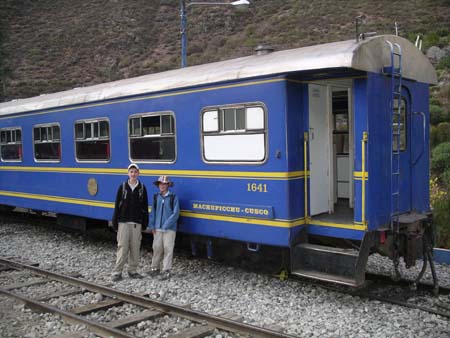
Paula: Our journey to Machu Picchu, the most famous Inca
ruins of all, began early this morning with a 7:00 AM train ride through the
Urubamba Valley. We hadn't realized how scenic this ride would be, as we had
wonderful views of snow-capped mount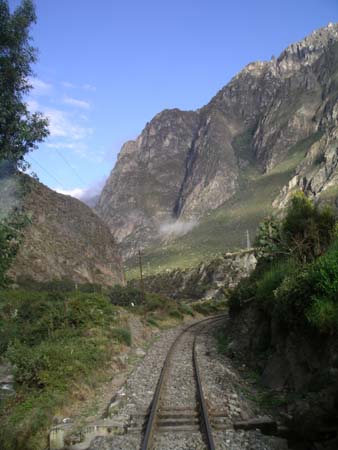 ains
and clouds hovering over the valley while made our way to the start of our
hike on the Inca Trail. The front of the train was an open window, so we were
able to capture some of the scenery with pictures (and movies) while looking
directly ahead. We quickly disembarked as our train made a momentary stop
at a suspension bridge (a place simply called
ains
and clouds hovering over the valley while made our way to the start of our
hike on the Inca Trail. The front of the train was an open window, so we were
able to capture some of the scenery with pictures (and movies) while looking
directly ahead. We quickly disembarked as our train made a momentary stop
at a suspension bridge (a place simply called 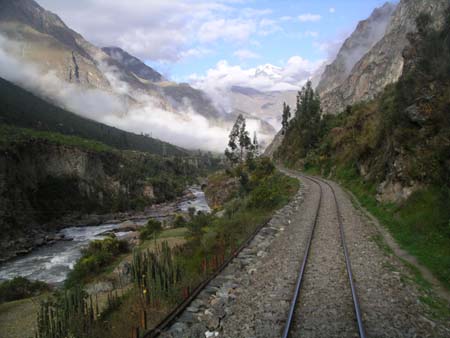 "Kilometer
104") where hikers are allowed to basically jump off and join one of
the five Inca trails that lead to Machu Picchu. Most of the passengers on
this train continue to the town of Aguas Calientes followed by a bus up to
Machu Picchu, but we had elected to spend the day walking the Inca Trail,
arriving in the late afternoon at the Sun Gate where our f
"Kilometer
104") where hikers are allowed to basically jump off and join one of
the five Inca trails that lead to Machu Picchu. Most of the passengers on
this train continue to the town of Aguas Calientes followed by a bus up to
Machu Picchu, but we had elected to spend the day walking the Inca Trail,
arriving in the late afternoon at the Sun Gate where our f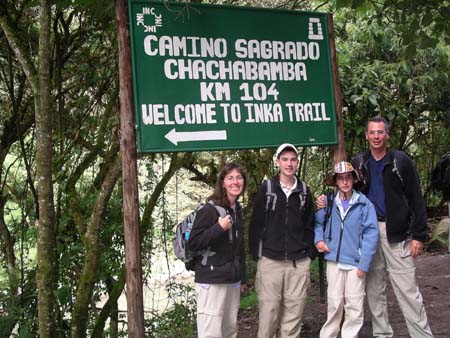 irst
view of the lost city would be from high in the mountains.
irst
view of the lost city would be from high in the mountains.
There are actually several ways to hike the Inca Trail, including a popular
four-day trek that ends at Machu Picchu. Our hike today would cover the last
12 kilometers of the trail, including some o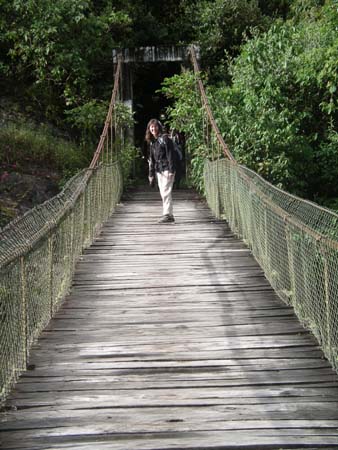 f
the more interesting ruins and sights along the way. Access to the Inca Trail
is actually very tightly controlled, and all hikers must be formally registered
and accompanied by a guide (we were even required to present our passports
at a checkpoint near the trailhead).
f
the more interesting ruins and sights along the way. Access to the Inca Trail
is actually very tightly controlled, and all hikers must be formally registered
and accompanied by a guide (we were even required to present our passports
at a checkpoint near the trailhead).
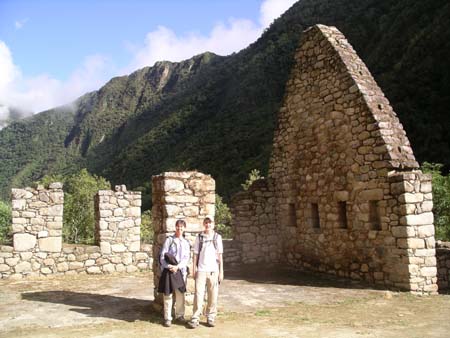 After
getting off the train and crossing the Urubamba River on a wooden suspension
bridge, we started our walk at an altitude of 2,170 meters. Chachabamba, the
remains of a small Inca religious site is near the head of the trail. These
ruins include a small alter that was used for making offerings to the river
as well as the homes for the priest who managed the site. We admired the stonework
that includes high gables to support the steep roof lines necessary here to
handle the large amount of rain that occurs during Peru's wet season.
After
getting off the train and crossing the Urubamba River on a wooden suspension
bridge, we started our walk at an altitude of 2,170 meters. Chachabamba, the
remains of a small Inca religious site is near the head of the trail. These
ruins include a small alter that was used for making offerings to the river
as well as the homes for the priest who managed the site. We admired the stonework
that includes high gables to support the steep roof lines necessary here to
handle the large amount of rain that occurs during Peru's wet season.
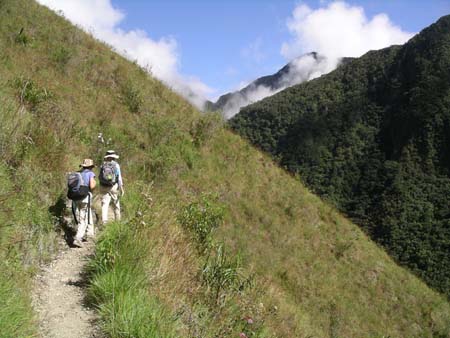
As we left the site, the trail immediately began a sharp pitch upwards which
often included stone steps placed by the Incas 600 years ago. We loved walking
on the Inca Trail, and marveled at the amount of work that must have been
required to establish this passage through very rugged terrain. 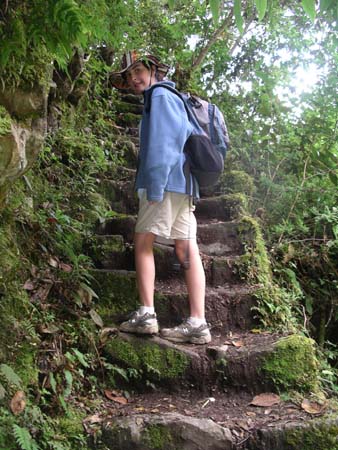 This
part of the trail was often steep, and we found ourselves needing frequent
rests, especially in the heat and high altitude. Initially the trail hugged
the eastern side of the mountain and in the dry, hot terrain we enjoyed the
many wildflowers growing along the slope. These
This
part of the trail was often steep, and we found ourselves needing frequent
rests, especially in the heat and high altitude. Initially the trail hugged
the eastern side of the mountain and in the dry, hot terrain we enjoyed the
many wildflowers growing along the slope. These 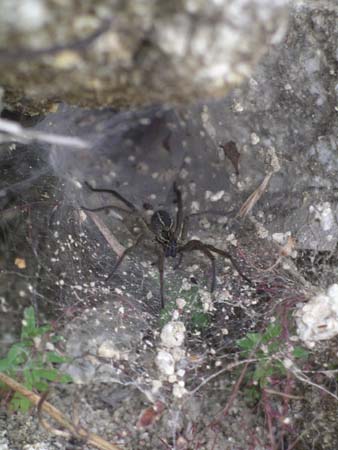 included
several varieties of orchids and asters.
included
several varieties of orchids and asters.
David and Katie quickly discovered that our path was lined by tarantulas in their easily distinguishable tunnel-shaped webs, and delighted in trying to get them to poke their heads out of their webs. Most of these were very small, and we looked hard for one of the larger spiders that we were told live here. We had never seen tarantulas in the wild, and hadn't realized that they live in such high altitudes.
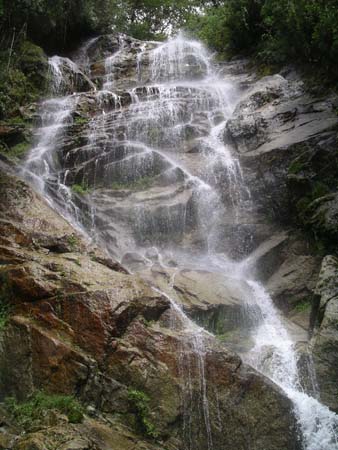 We
stopped for lunch at a lovely waterfall that marked the entrance to a cloud
forest. The air here was much cooler, and we enjoyed resting and eating the
box lunches that had been prepared for us at the hotel. Our food and drink
had been carried for us by a porter who accompanied us on the hike. We felt
a little guilty about this until we learned that on the 4-day version of the
Inca Trail hike, there are actually two porters required for each hiker! Also,
it turns out that this serves as very valuable employment for many men who
live in the highlands and towns surrounding Machu Picchu and the Sacred Valley.
We
stopped for lunch at a lovely waterfall that marked the entrance to a cloud
forest. The air here was much cooler, and we enjoyed resting and eating the
box lunches that had been prepared for us at the hotel. Our food and drink
had been carried for us by a porter who accompanied us on the hike. We felt
a little guilty about this until we learned that on the 4-day version of the
Inca Trail hike, there are actually two porters required for each hiker! Also,
it turns out that this serves as very valuable employment for many men who
live in the highlands and towns surrounding Machu Picchu and the Sacred Valley.
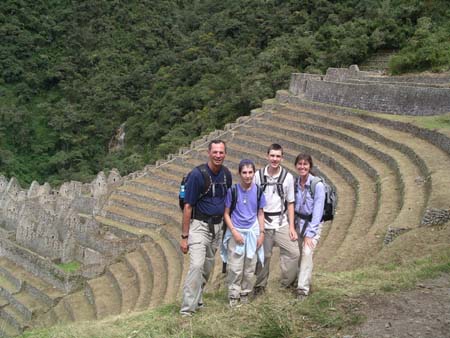
A large millipede and several beautiful birds entertained us as we made our
way next to a set of Inca ruins called Winaywayna. This part of the hike was
very interesting because the microclimate changes so rapidly along the trail.
We often found ourselves rounding a corner, 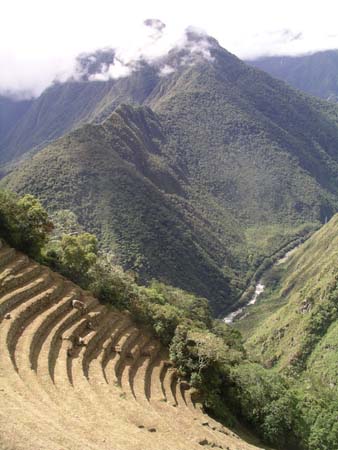 immediately
leaving a dry, arid terrain and entering a damp, moss and fern-covered cloud
forest.
immediately
leaving a dry, arid terrain and entering a damp, moss and fern-covered cloud
forest.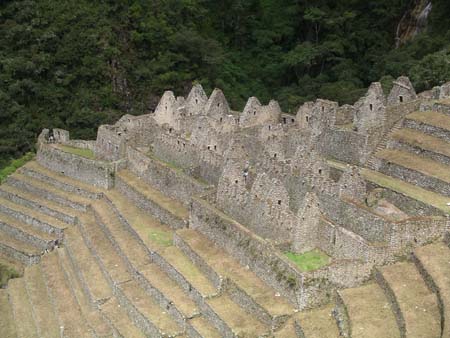
Winaywayna is visible well before the trail meets this large terraced area
surrounded by the ruins of several structures. Winaywayna means "forever
young" and this site is named after the wild orchid of the same name
which was found growing on the terraces when it was discovered in the 1950s.
Some feel the site was an important religious site while others feel it was
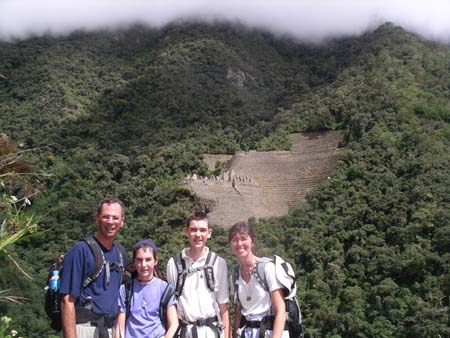 primarily
used to experiment in the farming of coca plants in the high altitude. The
site itself is magnificent and the view outstanding as it stands at 2,650
meters.
primarily
used to experiment in the farming of coca plants in the high altitude. The
site itself is magnificent and the view outstanding as it stands at 2,650
meters.
We learned at Winaywayna about how the Incas precisely constructed the terraces to create specific microclimates designed to support particular growing needs and experiments. The dimensions of the terraces changes based on altitude and direction, and much research has been done to try to understand what was behind these designs.
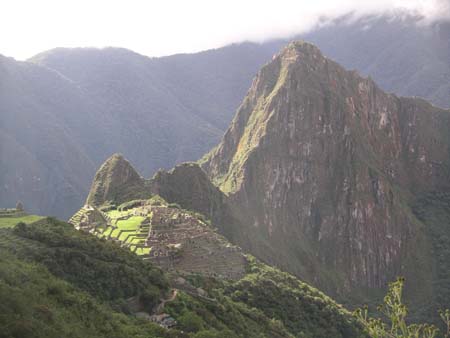
Finally, at around 3:00, we approached the Sun Gate with much anticipation. At an altitude of 2,745 meters, this was where we knew that we'd have our first view of Machu Picchu. As we arrived at the Sun Gate, Machu Picchu stood magnificently below us. It really was amazing and difficult to describe in words. We each tried to relish this first moment so that the vision would stay imprinted in our memories. We feel very fortunate to have seen so many architectural wonders from around the world, and are happy to be adding Machu Picchu to our list that already includes wonderful experiences at places such as Angkor Wat and the Great Wall of China.
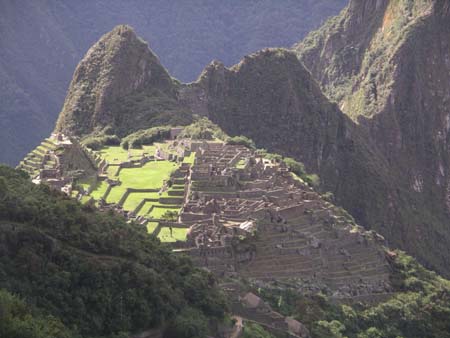 The
walk down to Machu Picchu and its guard house (the spot where all the classic
pictures are taken from) required another 45 minutes, passing a check point
where sacrifices were made and an Inca. We will not explore the main ruins
until tomorrow but thoroughly enjoyed sitting on the upper terraces admiring
the site and surrounding mountains. After seeing so many pictures of Machu
Picchu, it was really great to actually see the whole scene in person, and
enjoyed taking several photographs of our own.
The
walk down to Machu Picchu and its guard house (the spot where all the classic
pictures are taken from) required another 45 minutes, passing a check point
where sacrifices were made and an Inca. We will not explore the main ruins
until tomorrow but thoroughly enjoyed sitting on the upper terraces admiring
the site and surrounding mountains. After seeing so many pictures of Machu
Picchu, it was really great to actually see the whole scene in person, and
enjoyed taking several photographs of our own.
Considering the total distance (12 kilometers) and climb (600 meters) that we walked today, we all felt remarkably good. Having such a special destination definitely makes the walking much easier.
Tomorrow we will spend the day exploring Machu Picchu and the mysteries within its walls (after a well-deserved rest tonight...). We are staying right on site at the Machu Picchu Sanctuary, which where we can almost step outside the lodge directly into the ruins.
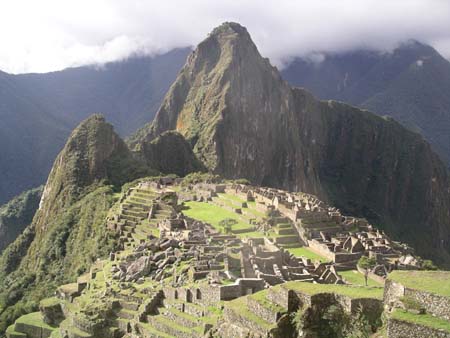
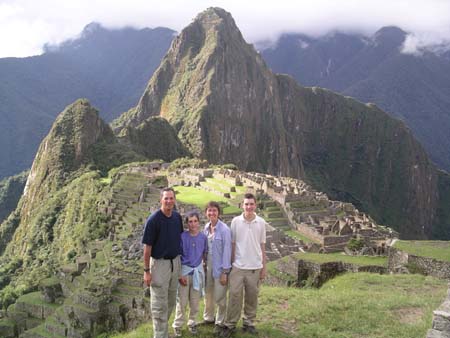
Wildflowers seen today:
Winaywayna Orchid
Ida Orchid
Indian Paint Brush
Asters
Fucia
Oreocalis
Companela
Wild Anis
Bamboo Orchid
Lady Slipper
Begonia
Vervenarea (Flower of 7 colors)
Bromeliads
Birds:
Blue & White Swallows
Continga
